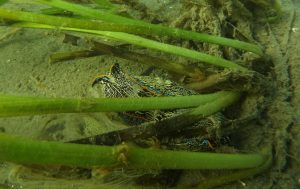Bight ’23 regional survey assessing ecological health of eelgrass beds for first time

The Southern California Bight 2023 Regional Monitoring Program has completed field sampling for a first-of-its-kind multiagency survey evaluating the health of the region’s eelgrass beds based on their ecological functioning – a regional effort that is expected to help close key data gaps as well as build California’s capacity to implement standardized, ongoing monitoring of this ecologically fragile habitat.
The Bight ’23 field sampling work, which wrapped up in December, is enabling researchers to test-drive newly developed bioassessment-based methods for quantitatively assessing eelgrass bed health. The methods evaluate the aquatic plants’ ability to provide refugia to fish and other animals, as well as other ecosystem services, including attenuating ocean waves and sequestering carbon.
Traditionally, eelgrass bed assessments in Southern California have focused primarily on documenting the locations and size of eelgrass beds.
Eelgrass beds, which are scattered across shallow, soft-bottom coastal areas of Southern California, are the dominant type of seagrass found in California’s coastal embayments. In recent years, California has invested significant resources into restoring and protecting seagrass beds, which have been decimated by a range of human activities.
Existing monitoring of Southern California eelgrass beds, however, has historically been uneven, with monitoring required at certain sites as part of regulatory compliance obligations, while other sites don’t get monitored at all or get monitored using less rigorous, non-standardized assessment methods.
The Bight ’23 Submerged Aquatic Vegetation (SAV) study element will use a set of consistent, robust assessment methods that were co-developed by SCCWRP in 2020 and piloted at smaller scales.
The regional assessment of eelgrass beds will enable coastal managers to place site-specific assessments into regional context, as well as enable managers to quantitatively assess the success of eelgrass restoration and mitigation projects, including for determining compliance with the California Eelgrass Mitigation Policy, which calls for no net loss of eelgrass habitat function.
More broadly, the assessment approach will help managers determine if coastal estuaries – of which eelgrass beds are a part – have achieved beneficial-use designations that are required under state and federal regulatory programs.
Eventually, the Bight ‘23 SAV assessment approach is expected to be incorporated into routine seagrass monitoring programs, including California’s Estuarine Marine Protected Areas (EMPA) program.
During the Bight ’23 field work, researchers collected data from 36 eelgrass beds across coastal Southern California over a two-month period. Researchers are now in the process of compiling and analyzing field data. Once the data are analyzed, researchers will use a condition index scoring tool co-developed by SCCWRP to produce an overall quantitative estimate of eelgrass condition.
The Bight ’23 SAV study is one of seven study elements of the Bight program, which runs in five-year cycles to investigate different aspects of coastal ecosystem health.
For more information, contact Dr. David Gillett.
More news related to: Bioassessment, Regional Monitoring, Southern California Bight Regional Monitoring Program, Top News